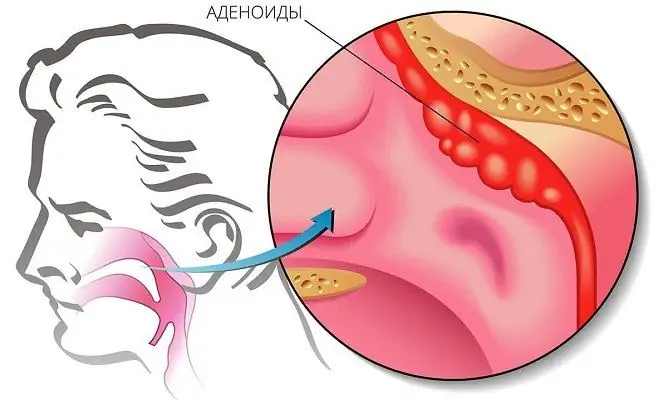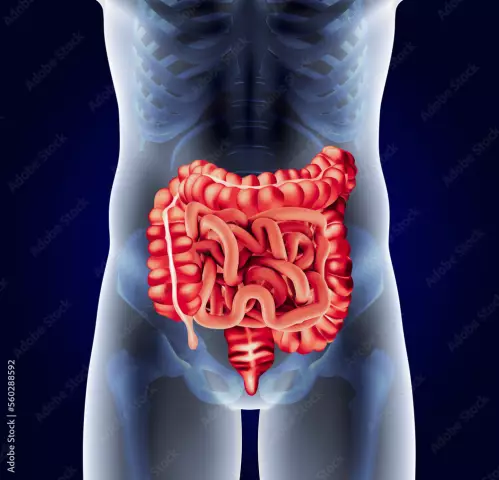- Author Rachel Wainwright [email protected].
- Public 2023-12-15 07:39.
- Last modified 2025-11-02 20:14.
Spastic colitis
The content of the article:
- Causes and risk factors
- Forms of the disease
- Spastic colitis symptoms
- Features of the course of the disease in children
- Diagnostics
- Spastic colitis treatment
- Possible complications and consequences
- Forecast
- Prevention
Spastic colitis (irritable bowel syndrome) is a bowel disease characterized by persistent dysfunction in the absence of organic causes. For the histological picture with spastic colitis, dystrophic tissue changes are more characteristic than inflammatory ones.

Stress and neurotic disorders are the main risk factors for developing spastic colitis
Spastic colitis is diagnosed in about 15-30% of the adult population, while only a third of the total number of patients who become ill seek medical help. Women are more susceptible to the disease, in whom it is diagnosed 2-4 times more often than in men. The average age of patients with spastic colitis is 20-40 years. After 60 years, pathology is rarely recorded; in the presence of symptoms of colitis in this age group, examination for organic lesions of the intestine is required.
The prevalence of the disease among children is high. According to epidemiological studies, the clinical picture of spastic colitis is observed in more than 50% of cases of recurrent abdominal pain syndrome in children.
Causes and risk factors
The causes of the onset of the disease are not well understood. No organic changes that could cause signs of spastic colitis were found. It has been established that the main risk factors for the development of pathology are stress and neurotic disorders (depression, insomnia, phobias, hypochondria). The high efficiency of placebo in the treatment of spastic colitis of the intestine is noted, which additionally indicates the dependence of the disease on psychological attitudes.
Other risk factors include:
- hereditary predisposition;
- transferred intestinal infections followed by dysbiosis;
- gynecological diseases;
- hormonal disorders;
- taking certain medicines (including antibacterial ones);
- unhealthy diet (low-quality foods, consumption of large amounts of gas-forming foods, fatty foods, alcohol abuse, excessive consumption of caffeine), non-compliance with the diet;
- lack of physical activity, sedentary work;
- frequent changes in climacteric zones;
- intestinal trauma.

Unhealthy diet is believed to be one of the causes of spastic colitis.
In children, in 30% of cases, the onset of the disease is associated with past traumatic situations, in another third of patients of this age group, pathology arose after an acute infectious disease of the gastrointestinal tract. In other cases, the appearance of spastic colitis in children is associated with such diseases in the anamnesis as perinatal encephalopathy, malnutrition in the first year of life, rotavirus and enterovirus infections, helminthic infestations, etc. Pathologies are more susceptible to children who are early transferred to artificial feeding, and who do not adhere to diet.
Forms of the disease
Depending on the clinical picture, the following forms of spastic colitis are distinguished:
- with a predominance of abdominal pain and flatulence;
- with a predominance of diarrhea;
- with a predominance of constipation;
- mixed.
Spastic colitis symptoms
The clinical picture depends on the form of the disease (chronic diarrhea or constipation, flatulence and abdominal pain, or a combination of these signs).
It is characteristic that the symptoms of the disease do not appear at night and do not interfere with the patient's sleep. For spastic colitis, a wave-like course without progression is characteristic, that is, without an increase in manifestations.
The main symptoms of spastic colitis include:
- discomfort or pain in the navel or lower abdomen after a meal, which usually diminishes or disappears completely after passing gas or having a bowel movement;
- feeling of incomplete bowel movement after a bowel movement;
- rare or, on the contrary, too frequent bowel movements (less than three times a week or more than three times a day, while the total mass of feces excreted per day usually does not increase);
- diarrhea after eating, usually in the morning;
- mucus in the stool;
- flatulence;
- belching with air;
- a feeling of heaviness and fullness in the stomach.

Spastic colitis is characterized by pain in the navel and lower abdomen after a meal
These symptoms often occur after prolonged nervous and / or physical strain, they may be accompanied by back pain, headaches, tinnitus, sudden weakness, insomnia, feeling short of breath (dissatisfaction with inhalation), feeling of a lump in the throat, dry mouth, frequent urge to urinate, inability to lie on the left side.
Abdominal pain with spastic colitis occurs against the background of intestinal spasms or excessive gas formation, followed by overstretching of the intestinal walls. The pain is aching, dull, or cramping. In women, pain attacks often worsen before or during menstruation.
About 20-60% of patients with spastic colitis have anxiety, panic attacks, hysteria, depression, sexual disorders, irritable bladder syndrome.

Panic attacks and anxiety are common companions of spastic colitis
No weight loss occurs in patients with spastic colitis. Relapses are usually caused by stressful situations.
Features of the course of the disease in children
With spastic colitis with a predominance of diarrhea, children have no diarrhea at night and appear in the morning, usually after breakfast. Diarrhea is often accompanied by bouts of spastic pain in the right iliac region.
With spastic colitis with a predominance of constipation in children, there is an irregular bowel movement (at least three times a week), a feeling of incomplete bowel movement. Constipation may be persistent, intermittent, or alternate with diarrhea.
With a mixed form of the disease, constipation alternates with diarrhea without a clear predominance of any one manifestation. In addition, patients complain of bloating, a feeling of bloating in the abdomen, flatulence, and abdominal pain.

In children, spastic colitis is often accompanied by diarrhea, alternating with constipation.
Extraintestinal manifestations of spastic colitis in children:
- swallowing disorder (dysphagia);
- heartburn;
- nausea;
- headaches;
- increased heartbeat (tachycardia);
- insufficiency of inspiration;
- insomnia;
- excessive sweating.
Often, the disease is accompanied by neurotic symptoms: anxiety, increased irritability, impulsive behavior are observed.
These symptoms with spastic colitis persist for at least three months.
Diagnostics
The diagnosis of spastic colitis is made by excluding organic intestinal lesions. Diagnostics is based on data obtained as a result of laboratory and instrumental examination:
- general and biochemical blood test;
- coprocytogram;
- laboratory examination of feces for helminth eggs, bacteria, occult blood;
- digital rectal examination;
- X-ray of the large intestine with contrast (irrigoscopy);
- endoscopic examination of the rectum and distal sigmoid colon (sigmoidoscopy);
- endoscopic examination of the large intestine (colonoscopy);
- Ultrasound of the abdominal and pelvic organs;
- computed tomography of the intestine.

Laboratory examination of feces is part of the comprehensive diagnosis of spastic colitis
For women with suspected spastic colitis, a gynecological examination is indicated.
Differential diagnosis is required with diseases, the development of which is based on organic changes in the organs of the gastrointestinal tract. In the presence of similar symptoms, the organic causes of the disease can be suspected in the following cases: the patient's advanced age, cancer in the family history, fever, abnormalities in laboratory results, identification of changes in internal organs, weight loss, manifestation of signs of colitis at night.
Iron deficiency anemia, deficiency of B vitamins should be excluded.
Spastic colitis treatment
Spastic colitis is treated with conservative methods. Since the exact cause has not been identified, therapy is symptomatic. For constipation, laxatives are prescribed, for diarrhea, fixing agents are indicated. If necessary, enzyme preparations are prescribed (in order to improve digestion), as well as preparations for stopping flatulence. Antispasmodics are used to relieve intestinal spasms. In order to normalize the intestinal microflora, pro- and prebiotics can be prescribed.
Physiotherapy provides a good effect: paraffin or mud applications on the abdomen, reflexotherapy, electrophoresis, therapy with sinusoidal modulated currents, as well as massage of the anterior abdominal wall.
Due to the fact that nervous overstrain usually plays an important role in the development of the disease, patients with spastic colitis need to stabilize the emotional state. Antidepressants and / or antipsychotics may be required. Mild herbal sedatives are indicated for insomnia. In some cases, it is recommended to undergo a course of psychotherapy, which reduces the level of anxiety and tension of the patient.

Mud therapy is effective for spastic colitis
Achieving sustained remission is impossible without lifestyle modifications. Patients should normalize the daily routine, avoid stressful situations, and increase physical activity. Diet is recommended. Avoid eating foods that can irritate the mucous membrane of the digestive tract, promote excessive production of gastric juice and bile, mechanically damage the mucous membrane of the intestinal wall. It is necessary to exclude alcoholic and carbonated drinks, coffee, chocolate, smoked, salty, fatty and spicy foods from the diet, as well as foods that cause increased gas formation (baked goods, cabbage, legumes, grapes, etc.), canned food. Food is boiled, stewed or steamed.
The choice of treatment regimen for spastic intestinal colitis in children depends on the form of the disease, however, nutritional correction is indicated in all cases. Animal fats, fast food, chocolate, milk, carbonated drinks, legumes, cabbage, black bread are excluded from the diet.
As in adults, laxatives are indicated for constipation; in case of diarrhea, enterosorbents, antidiarrheals, and intestinal antiseptics are prescribed. Antispasmodics are prescribed if necessary. The normalization of the child's mental state and sufficient physical activity are of great importance.
Possible complications and consequences
Despite the long course of the disease, with spastic colitis there is no tendency to an increase in symptoms and the development of other pathological processes on the part of the digestive tract. The disease reduces the quality of life, but does not lead to any complications or long-term consequences.
Forecast
The prognosis is favorable on condition of successful correction of background neuropsychiatric disorders.
Prevention
In order to prevent the development of spastic colitis, as well as to prevent recurrence of the disease, it is recommended:
- timely treatment of nervous disorders;
- avoidance of prolonged mental stress;
- normalization of the daily routine;
- sufficient physical activity;
- regular walks in the fresh air;
- rejection of bad habits;
- balanced diet.
YouTube video related to the article:

Anna Aksenova Medical journalist About the author
Education: 2004-2007 "First Kiev Medical College" specialty "Laboratory Diagnostics".
The information is generalized and provided for informational purposes only. At the first sign of illness, see your doctor. Self-medication is hazardous to health!






